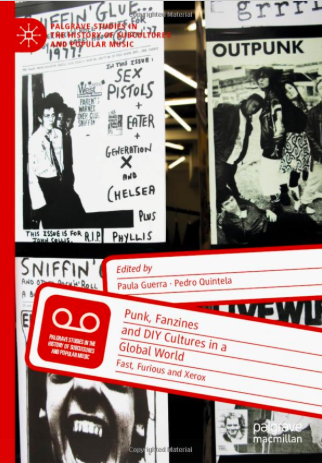
I’m delighted to have written a foreword for Paula Guerra and Pedro Quintela’s new collection of essays, Punk, Fanzines and DIY Culture in a Global World: Fast, Furious and Xerox (Palgrave, 2020). Here it is, entitled ‘The attractions of the fanzine.’
When I was starting out as a scholar in the early 1990s, my youthful punk rock, anarchist, free festival and squatting years from the late 1970s on gave me a gift I was not expecting and had not anticipated: a subject to write about. To be accurate: a subject to write about again, for I had already kept a daily diary from around 1979-1980.
In my first book Senseless Acts of Beauty: Cultures of Resistance since the Sixties (1996) I tried to make sense of culture I knew like Crass and Stonehenge Free Festival by tracing strands of and connections between the counterculture in Britain from the 1950s and 1960s on. In that book’s kind of companion collection, DiY Culture: Party & Protest in Nineties Britain (1998), I tried to bring together key voices in the then newest version of countercultural protest, from underground ‘rave’ culture to road protest and radical environmentalism.
In Senseless Acts of Beauty, documents and ephemera like record covers, and self-produced music and politics magazines, leaflets and flyers appeared as both primary sources and evocative visual illustration. But by DiY Culture, there were chapters dedicated to alternative and independent media production, from underground magazines to alternative news videos.
The history and practices of alternative media were becoming of greater interest, not only to veterans who had been involved in various media scenes from the Sixties underground press on, but also to new generations of media activists. There was in the 1990s an energy around media innovations (discuss) like subvertising, the Zapatistas and Indymedia which needed explaining and historicising.
In a British context, the timely and important work of Chris Atton I found pivotal here—starting with Alternative Media (2001), Atton helped make a critical and theoretical space available for the study of such radical ephemera. In my own university I designed and taught a new course called Alternative Media, which politically-minded students from Media Studies, Cultural Studies, American Studies eagerly enrolled on.
For these students there was nothing quite like handling and reading the small collection of original Oz and IT underground magazines from the 1960s, and fanzines like Sniffin’ Glue, Kill Your Pet Puppy and Toxic Graffiti from the 1970s, that I would distribute for seminar discussion. They would have very much enjoyed and found usefully informative a book like this one, which is a rich and vibrant collection.
Its innovations are plural, headed by the international perspectives the chapters herein offer, as well as tracing the (perhaps surprising) continued influence and sense of relevance of punk fanzines over decades now. Chapters show how fanzines can be inclusive (as social, queer or intersectional text) as well as exclusive (this music only). The sheer range of images contained is a further asset. I like that the title contains the word ‘fanzine’ rather than, common today, ‘zine’—it maintains in my view the centrality as producer and consumer of the fan, a term which is, as Adorno tells us, ‘short for fanatic’ (1967, 123). I congratulate the editors, Paula Guerra and Pedro Quintela, and all contributors on their efforts and hope other readers will find its illuminations to be both as detailed and wide-ranging as I have.
Few of the punk singles from Back In The Day that I still carry with me from one house or job move to the next have had that much of a listen in recent years—when someone from a band dies I dig them out for a spin. But the fanzines—those I look at, I could say cherish (though what have I done with my now precious copies of Sniffin’ Glue? All I can find is my flexi-disc of Alternative TV’s ‘Love lies limp’, given free with the final issue. I hope to find them in a dusty folder sometime). Some of the best band interviews were to be found in the informal space of fanzines, as well as some of the best and/or worst punk graphics.
As a teenage punk I always liked the idea that the fanzine was just stapled together, that the writer or maker really could have been, well, someone like me, a boy in a provincial town, feeling it deeply. The fanzine seemed even more accessible in punk than being in a band or making a record, even though each of these core activities had itself been greatly demystified and democratised by punk. As Atton would explain to us later, the fanzine knocked the hierarchy of access. Also it was public culture—unlike the private diary-writing I was starting to do, fanzine production was for public consumption, it was part of the gig.
I remember at one concert a punk selling his fanzine with the disarming slogan: ‘Buy this. It’s shit but it’s cheap.’ It really was cheap, too, though I remain to this day uninformed as to its quality. I never did buy that one, not even for the five pence demanded. I wish I had.
